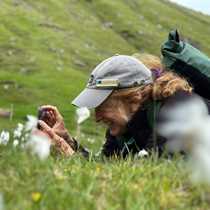Astoria, Fort Clatsop & Cape Disappointment
With a sliver of a moon in the western sky and the glowing promise of sunrise to the east, we greeted the day at the mouth of the mighty river of the west, the Columbia. The gentle undulation of Pacific swell under out feet gave away our location before we peeked outside our cabins. Brown pelicans, surf scoters and cormorants all flew towards the breakers with a sense of purpose. We too had a sense of purpose and after viewing the bird life, breakers and the blinking lights of the Cape Disappointment lighthouse, we set our sights toward Astoria.
Fort Clatsop was the 1805-06 winter home of the Corps of Discovery. In contrast to the seabirds at dawn, we found ourselves in a shaded spruce forest filled with chirping juncos, sparrows, chickadees and chattering squirrels. There were other delights as well: colonies of colorful plump and frilly mushrooms, delicate webs with a single spider ornament strategically placed in the center, and crisp fresh air inviting you to breathe in deeply. The words we had read and heard today of the winter of 1805-06 being uncomfortably cold and wet, amongst the company of multitudes of fleas and half-rotten elk for rations could only be imagined, as our day was sunny, warm and free of any insect infestations.
In the afternoon the Astoria Column beckoned those in search of an awesome view of Astoria and points beyond; some ambitious individuals climbed the 164 steps to the top and released tiny balsa wood airplanes to the whims of breeze and lift. Others felt compelled to finish their journey with an excursion to the Pacific Ocean. We rode to the state of Washington and visited the Lewis and Clark Interpretive Center. Perched high on a rocky bluff, this site has many facets, including the Cape Disappointment lighthouse, one of the Maya Lin Confluence project installations and an awesome view of the Pacific Ocean. We returned to the National Geographic Sea Bird with sand in our shoes and a satisfied feeling of a journey complete.




